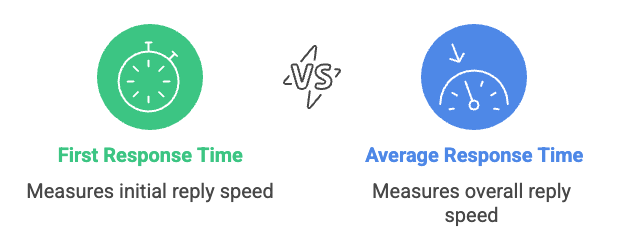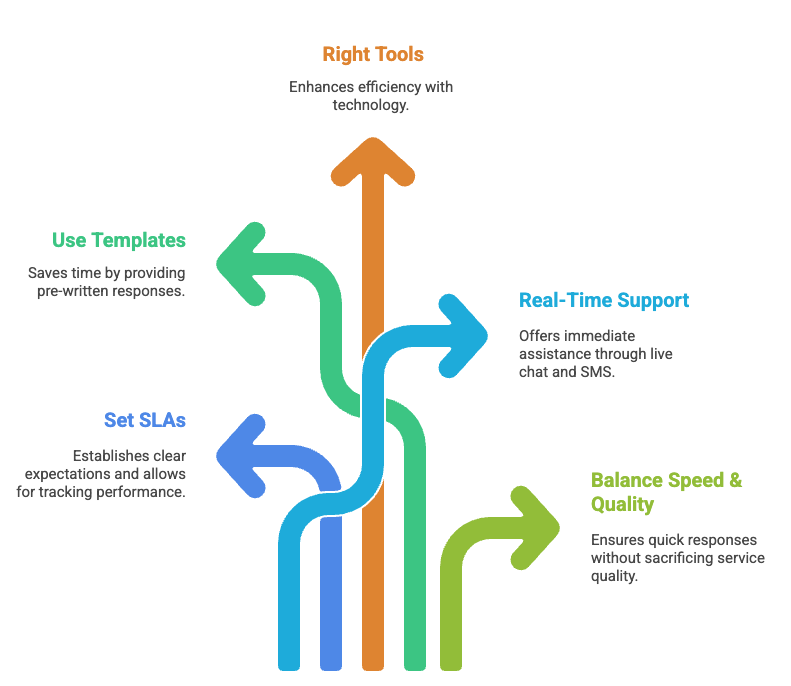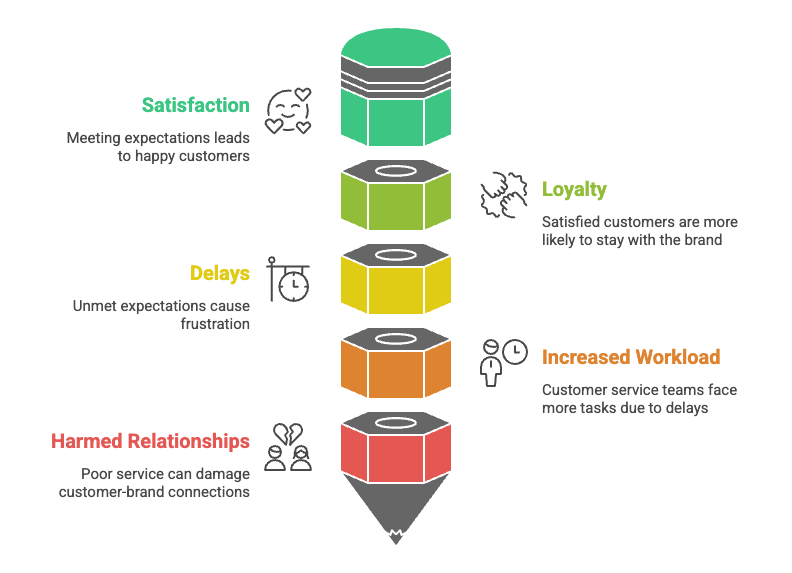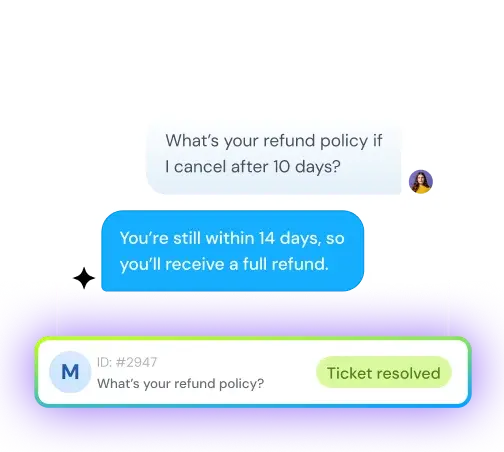10 Ways to improve your customer service response time today
Vaishali Jayaprakash
Sep 23, 2025

Imagine messaging a brand with a simple question… and then waiting hours, or worse, days.
Now imagine getting a reply in minutes.
That tiny difference completely changes how customers feel about you.
Today, response time isn’t just a metric—it’s the moment your customer decides whether they trust you or not. And with most customers expecting an “immediate” reply in 10 minutes or less, slow responses aren’t just frustrating, they’re a business risk.
This blog breaks down why response time matters more than ever and five practical ways you can speed it up starting today.
Understand what response time really means
A clear understanding of "response time" in customer service operations should come before any improvement strategies. Many companies track these metrics without really knowing what they measure or how they affect customer satisfaction.
First response time vs average response time

First response time (FRT) shows how quickly your team gives their first meaningful reply after a customer asks a question. The clock starts when customers submit their question and stops once they get their first real response from a support agent. FRT stands out as a significant customer service metric because it kicks off customer interaction and lets them know someone's working on their problem.
Average response time (ART) measures how long your team takes to respond throughout an entire conversation. This covers all the messages after that first reply. FRT zeros in on that vital first acknowledgment, while ART helps you learn about the overall efficiency of your back-and-forth communication.
These metrics serve different purposes:
- FRT reveals your speed in acknowledging new customer issues
- ART shows how well you handle ongoing conversations
The tone for customer experience depends on first response time. Jamie Edwards, COO of Kayako, puts it well: "First reply time is more important than overall reply times because it's an acknowledgment to the customer that their issue is being looked into". Quick responses build trust. Delays tell customers they're not a priority.
Your team might also track average resolution time. This combines both metrics to show how long it takes to solve a customer's problem from beginning to end.
Why auto-replies don't count
Companies often make a mistake by including automated responses in their calculations. This paints an unrealistic picture that doesn't match what customers actually experience.
Automated messages don't qualify as first responses for several clear reasons:
- They don't offer real help with specific customer issues
- They lack personal touch or customization
- They fail to show that a real person is handling the problem
The timer begins when customers submit their question but only stops when they get a real, personalized reply from a support agent. A generic "We've received your message" doesn't stop the FRT clock - only meaningful human interaction does.
Auto-responders play a useful role in confirming message receipt, but they shouldn't factor into your team's response speed measurements. Bri Christiano, Director of Customer Support at Gorgias, explains it perfectly: "Even if you can't solve the question right away, letting the customer know you received their inquiry — and that it didn't get sent into the void — is great for customer confidence and satisfaction".
How to calculate your current response time
Your response time calculations need two key pieces of information:
- Total time spent responding to customer inquiries
- Total number of inquiries received
The first response time formula looks like this: FRT = Total response time ÷ Number of tickets
Here's a real example: Your clothing store handled 120 support cases this week with combined first response times of 15,000 seconds. The math would be: 15,000 ÷ 120 = 125 seconds average first response time
These factors matter for accurate measurements:
- Business hours only: Count time during operating hours only. A customer email at 10 PM with an 8:05 AM response the next day (office opens at 8 AM) means 5 minutes FRT, not 10 hours and 5 minutes.
- Use median values: Median response times work better than averages because outliers won't throw off your results. Take four FRTs of three minutes and one of 30 seconds - the median (3 minutes) tells a more accurate story than the average (2 minutes, 30 seconds).
- Channel-specific benchmarks: Each communication channel creates unique response time expectations. Email responses should come within four hours, ideally under one hour. Social media needs responses within one or two hours. Live chat demands immediate replies (under a minute).
- Exclude automated responses: Remember to count only meaningful human responses in your metrics.
Modern help desk software tracks these metrics automatically. This saves manual work and provides real-time performance monitoring. You can break down data by agent, team, channel, or time period to spot areas needing improvement.
Proper tracking and understanding of response time metrics helps meet customer expectations.
Clear distinction between metrics and accurate calculations give you informed views of your team's performance. This knowledge points to the most effective areas for improvement. You can set achievable goals and watch your progress as you work to speed up customer service response times.
10 Ways to improve your customer service response time today
You now understand why fast response times matter. Let's take a closer look at practical strategies you can use today. These five approaches need minimal setup time and will give immediate improvements in your team's response speed to customer inquiries.

1. Set clear SLAs and track them
Service Level Agreements (SLAs) establish specific response time targets for your team. According to Salesforce research, 88% of customers say the company's experience matters as much as its products or services. Clear SLAs help meet these expectations.
Your team should define realistic timeframes for different customer inquiries. SLAs should include:
- First response time targets
- Resolution time expectations
- Business hours definitions
- Different standards based on ticket priority
Making SLAs visible and trackable is crucial. Modern helpdesk platforms like SparrowDesk let you set up automatic alerts when tickets approach SLA breach thresholds. This visibility creates accountability and helps agents manage their workloads better.
Try SparrowDesk free and see how fast your team can actually move.
14-day free trial • Cancel Anytime • No Credit Card Required • No Strings Attached
SLAs shouldn't exist just as internal documents. They establish clear objectives for your support team. These policies specify how quickly agents must respond to and resolve issues. Specific standards get met because "what gets measured gets done".
Different SLA tiers based on ticket priority levels make sense. One source points out, "Set different performance goals based on ticket priority levels. Your service desk team won't treat a printer failure as its highest priority ticket on an average day". This approach gives critical issues the swift attention they need.
2. Use templates and saved replies
A library of pre-written responses cuts response time drastically for recurring questions. These templates (or "canned responses" or "saved replies") let agents answer common questions with just a few clicks.
Industry data shows canned responses help support teams answer repeat questions quickly—maintaining consistent tone and content. They help new customer service agents learn faster and make fewer response errors.
Your team can implement this strategy by:
- Identifying most common customer inquiries
- Creating clear, friendly templates for each scenario
- Organizing templates into categories for easy access
- Training agents to personalize templates before sending
Customer service platforms come with built-in template functionality. Helpwise lets administrators "categorize saved replies into categories and assign them to inboxes, allowing agents to easily find the appropriate template".
Templates ensure your brand voice stays consistent across customer interactions. Just guide your team on personalizing templates—customers spot generic copy-paste responses easily.
3. Use the right tools to support faster replies
The right technology can make a huge difference in your customer service response time. Your tools either help you reply quickly or create bottlenecks that frustrate customers and agents.
Helpdesk software vs shared inbox
Many teams start with a shared inbox like [email protected]. This works at first but creates problems as volume grows. Teams face issues when multiple members access the same emails. This often leads to "agent collision" - two people answering the same customer and creating confusion.
Helpdesk software fixes these problems with ticket tracking, clear ownership, and optimized processes. Companies that use dedicated customer service software handle tickets 35% faster and get better customer satisfaction scores. Helpdesk systems also provide important insights into performance metrics like first response time (FRT) that shared inboxes can't match.
Modern tools like SparrowDesk make this even easier by combining ticket tracking, AI routing, and SLA monitoring in one clean interface.
14-day free trial • Cancel Anytime • No Credit Card Required • No Strings Attached
Here are the main differences:
- Ticket tracking: Helpdesks create unique tracking numbers for each customer's issue
- Assignment rules: Customer issues go automatically to agents with the right expertise
- Collaboration tools: Internal notes and mentions keep the team informed without confusing customers
- Analytics: Detailed reports on response times and other key metrics
Small teams should know that shared inboxes often result in missed emails, duplicate replies, slow responses, and no clear accountability for solving issues. These problems directly affect response times and customer satisfaction.
Time-based alerts and routing rules
Time-based alerts help catch issues before they slip through. These notifications flag unanswered emails after a set time—like 30 minutes or 2 hours—based on your SLA goals.
Setting up alerts by team, inbox, or individual user means follow-ups don't depend on someone checking old tickets. Managers can see reports that show how often alerts happen, which helps spot workflow problems.
Time-based routing rules also help manage customer interactions during specific business hours. Organizations with multiple locations can tailor call routing for each location's hours, which ensures good service across time zones.
Standard setup includes:
- Custom hours for specific weekdays
- Time intervals for each day
- Different routing paths during and after business hours
These automated systems create safeguards against delayed responses. This matters because customers who don't get quick replies are twice as likely to try another channel—which doubles your work.
4. Live chat and SMS for real-time support
Live chat and SMS stand out as tools for immediate customer help. These channels let you solve problems in real-time, something email can't match.
Website live chat lets visitors get quick answers through their preferred channel. Most customers prefer live chat over email and calls.
With SparrowDesk Live Chat, that experience gets even stronger.
Our AI auto-resolves up to 60% of routine queries, so customers get instant answers without waiting. And when an issue needs a human touch, SparrowDesk provides a seamless handoff to the right agent, no context lost, no repeated explanations, just smooth support from start to finish.
14-day free trial • Cancel Anytime • No Credit Card Required • No Strings Attached
Text messaging (SMS) shows great results too—companies find that 95% of their text messages get read within three minutes. Customers are four times more likely to respond to texts than return voicemails.
Modern platforms make these tools powerful by letting you:
- Handle all customer conversations from one screen
- Give instant responses on every channel
- Learn about visitors before they reach out
- Track satisfaction through chat ratings
One central inbox for all channels keeps customer questions from getting lost. A customer shares: "With Intercom, we have almost all of our support channels integrated into one system, making it easy for us to manage our support, as well as conduct analysis so we can take a data-driven approach to continuously improving our service".
The best strategy combines these real-time channels with your main helpdesk. This creates a smooth experience no matter how customers contact you. Such an approach ensures fast, consistent responses that meet today's customer expectations.
5. Balance speed with quality
Quick responses matter a lot, but speed isn't everything to your customers. The best support teams know how to balance swift replies with meaningful help. Let's see how you can achieve this balance without compromising either aspect.
Avoid robotic replies
Your customers hate talking to service reps who sound like robots reading from scripts. This "uncanny valley" of customer service happens when your frontline staff can only stick to procedures—even if those procedures make no sense in specific cases.
You can sound more human by:
- Writing short, simple messages instead of long, corporate-sounding paragraphs
- Letting minor typos stay to show your human side—they prove a real person helps
- Using emoticons wisely when customers use them first to build rapport
- Adding personal touches to canned responses
Your employees need common sense authority to solve problems quickly and create more human experiences. This prevents the delays and frustrations that come when agents must blindly follow rulebooks.
Focus on first contact resolution
First contact resolution (FCR) shows how many customer issues get solved in the first interaction. The industry calls a 70-79% FCR rate good, but only 5% of support teams reach the "world-class" level of 80% or higher.
Strong FCR rates help everyone:
- Customers feel less frustrated and more satisfied
- Agents handle fewer repeat contacts about the same issue
- Support costs go down—each 1% FCR improvement reduces operating costs by 1%
Good FCR needs well-trained agents who can access complete customer information. Agents provide better service when they see a customer's whole conversation history and context in one view.
Monitor CSAT alongside FRT
Speed matters but quality shouldn't suffer. That's why top teams track Customer Satisfaction Score (CSAT) with First Response Time (FRT).
CSAT measures customer satisfaction with support directly through 1-5 scale surveys after interactions. The math is simple: take the number of satisfied customers (4s and 5s), divide by total survey responses, and multiply by 100.
The connection between these metrics shows interesting trends:
- Each 1% FCR improvement leads to 1% higher customer satisfaction
- Quick responses without solutions create bad experiences—nobody likes getting passed between agents
- Customer effort score (CES) tells you how hard customers worked to fix their problems
The aim isn't just quick replies—it's giving complete solutions that respect customer time. Tracking both speed and quality metrics gives you a clear view of your team's performance and shows where to improve.
6. Implement smart ticket prioritization (Not all tickets deserve equal speed)
One of the biggest mistakes support teams make is treating every ticket the same. In reality, customer issues vary widely in urgency, business impact, and emotional intensity. When low-impact queries clog the queue, critical issues wait longer — and response time metrics suffer as a result.
Smart ticket prioritization solves this by automatically sorting incoming tickets based on predefined rules. These rules can consider factors such as:
- Issue type (billing, outage, login failure)
- Customer tier (free vs paid vs enterprise)
- Keywords indicating urgency (“down,” “urgent,” “can’t access”)
- Channel used (chat vs email)
By ensuring high-priority tickets are surfaced immediately, agents can respond faster where it matters most. This not only improves first response time but also reduces escalations and customer frustration. Prioritization creates clarity for agents, removes guesswork, and prevents important tickets from slipping through the cracks during busy periods.
7. Use analytics to identify and fix response time bottlenecks

If your response time is slow, the real problem usually isn’t effort — it’s visibility.
Support analytics help you understand where and why delays are happening. Instead of guessing, teams can use data to uncover patterns like:
- Certain hours or days when response times spike
- Specific channels that consistently lag
- Issue categories that take longer to respond to
- Agents who are overloaded or underutilized
With these insights, managers can make informed decisions — whether that means adding coverage during peak hours, redistributing workloads, or improving internal workflows. Analytics also help you measure the impact of changes over time, ensuring improvements actually stick.
When response time optimization is driven by data instead of assumptions, teams can fix problems proactively rather than reacting after customers complain.
Tools like SparrowDesk bring response-time analytics, channel performance, and agent workload data into a single dashboard, so teams don’t have to piece insights together from multiple tools.
See how SparrowDesk helps teams spot and fix response time bottlenecks in real time.
14-day free trial • Cancel Anytime • No Credit Card Required • No Strings Attached
8. Expand self-service to reduce response time at the source
The fastest response is often the one that doesn’t require a response at all.
Self-service resources like knowledge bases, FAQs, and in-product help guides empower customers to resolve common issues instantly. Password resets, setup questions, feature explanations — these don’t always need an agent, yet they make up a large portion of inbound tickets.
By expanding self-service, you reduce overall ticket volume, which directly improves response times for tickets that do require human support. Agents spend less time answering repetitive questions and more time handling complex or urgent issues efficiently.
Effective self-service also improves customer satisfaction. Customers get immediate answers, agents face less pressure, and your support operation becomes more scalable without adding headcount.
Platforms like SparrowDesk make this simpler by connecting your knowledge base, FAQs, and in-app help directly to your support workflow — so customers see relevant answers before they ever submit a ticket.
This way, common questions are deflected automatically, agents stay focused on higher-impact issues, and response times improve naturally as ticket volume drops — without needing to expand your team.
👉 Discover how SparrowDesk turns self-service into faster support outcomes.
14-day free trial • Cancel Anytime • No Credit Card Required • No Strings Attached
9. Invest in continuous agent training for faster, more confident responses
Speed in customer support isn’t about typing faster, it’s about knowing exactly what to say and how to say it.
Agents who are well-trained respond more quickly because they don’t need to search for documentation, ask teammates for help, or escalate unnecessarily. Continuous training ensures agents stay up to date on product changes, common issues, and best practices for communication.
Key training areas that impact response time include:
- Deep product knowledge to reduce hesitation
- Clear writing skills to avoid back-and-forth
- Tool proficiency to navigate tickets efficiently
- Decision-making confidence to resolve issues independently
When agents feel confident, responses become faster, clearer, and more effective. Over time, this improves both response time metrics and first-contact resolution rates — a win for customers and support teams alike.
10. Offer asynchronous support options like scheduled callbacks
Instant responses aren’t always realistic especially for complex or sensitive issues. This is where asynchronous support options can significantly improve perceived response time.
Features like scheduled callbacks allow customers to choose a convenient time to speak with support instead of waiting in long queues or for immediate replies. While the issue may take time to resolve, customers appreciate knowing when they’ll hear back.
For support teams, callbacks reduce pressure on real-time channels and allow agents to prepare in advance. This leads to more efficient conversations, fewer follow-ups, and quicker overall resolution — even if the first response isn’t instant.
Asynchronous options balance speed with quality, helping teams manage workloads without sacrificing customer experience.
Why fast response times matter more than ever
Customer service has transformed in recent years. Response time now makes or breaks business success. Today's consumers expect quick replies - it's no longer just a nice-to-have feature.

Customer expectations
Today's customers need answers now. Studies show that 90% of customers rate an "immediate" response as important for customer service questions. Even more telling, 60% believe "immediate" means within 10 minutes.
This urgency makes sense in our connected world. People who get instant results everywhere else expect the same from customer service.
Customer demands keep growing. Many industries face intense time pressure—35-50% of sales go to the vendor who responds first. Quick replies create lasting first impressions that stick.
We live in times where patience runs thin. A HubSpot study reveals 33% of customers hate waiting on hold.
Impact on satisfaction and loyalty
Response speed builds deeper customer relationships beyond just temporary happiness. Quick responses create trust and encourage customers to stick around.
Fast answers make customers feel important. This directly boosts business results. Shopify's research states: "The difference between companies with loyal customers and those struggling to keep them comes down to customer service speed".
Speed's connection to loyalty goes beyond single purchases. The CMO Council found response time leads to customer satisfaction metrics. Slow responses can hurt badly.
How delays increase workload
Slow responses create more work for your team, not less. This happens in several ways.
Unanswered questions create multiple follow-ups. Consider this example: "Your team misses a Twitter response. The customer sends emails and starts a live chat. Your support team now faces extra work because of one slow response".
Support teams call this "ticket inflation" - one question creates several tickets on different channels. Agents waste time connecting these scattered conversations instead of helping new customers.
Late responses need more explaining and relationship fixing. Agents spend extra time apologizing for delays and rebuilding trust rather than solving the original problem.
Poor service strains both customer relationships and team resources. "Extra follow-ups and fixes increase staff workload and operational costs". More tickets lead to slower responses, creating even more tickets - a nasty cycle.
Backlogs become serious during busy times. When emails pile up faster than responses, the problem grows as representatives handle old messages while new ones arrive. Each day makes the backlog worse.
Quick responses don't just please customers - they create efficiency and help your bottom line. Preventing ticket inflation and reducing follow-ups helps your team serve more customers with less effort.
Response time sets companies apart in competitive markets. Businesses that respond quickly build stronger relationships, keep more customers, and work more efficiently. Rising customer expectations create both challenges and opportunities.
This piece will explore practical ways to help your business meet customer expectations without sacrificing quality.
Key takeaways on improving your customer service response time
Quick response times define great customer service today. Customers now expect answers within minutes, not hours or days. Your business can get ahead of competitors by meeting these expectations.
You can improve your response times immediately with these five practical strategies. Setting clear SLAs builds accountability, while templates help save time. AI automation takes care of simple queries, and smart prioritization puts urgent issues first. Good training gives your team the skills to respond quickly and well.
Note that speed isn't everything when it comes to customer satisfaction. Quality carries equal weight. The sweet spot between quick responses and complete solutions creates exceptional customer experiences. Getting it right the first time remains a vital goal along with faster replies.
The tools you choose make a significant difference. Helpdesk software with time-based alerts catches every ticket. Customers prefer live chat and SMS because these options provide immediate support.
Response time has a direct effect on trust, loyalty, and revenue. Companies that answer quickly stand out because most businesses don't meet customer expectations. These strategies will boost both customer satisfaction and efficiency when you start using them today.
Quick Summary: 10 Ways to improve your customer service response time today
Customers today expect replies within minutes, not hours. Nearly half consider an “immediate” response to mean 10 minutes or less, yet many businesses still lag behind. Slow replies damage trust, increase workload, and drive customers away, while fast responses build loyalty and efficiency.
This blog explains what customer service response time really means, how to calculate it, and why auto-replies don’t count. It highlights the impact of speed on satisfaction, retention, and operational costs. Finally, it shares five practical strategies to improve response times:
- Set clear SLAs and track them
- Use templates and saved replies
- Adopt the right help desk tools and routing rules
- Offer real-time channels like live chat and SMS
- Balance speed with quality through personalization and FCR
Bottom line: Faster, meaningful responses strengthen relationships, prevent backlogs, and set your business apart in competitive markets.
Frequently Asked Questions
While expectations vary, most customers consider an "immediate" response to be within 10 minutes. For email, aim to respond in under 4 hours, with 1 hour or less being ideal. Social media responses should come within 1-2 hours, while live chat requires immediate responses (under a minute).
Businesses can improve response times by setting clear Service Level Agreements (SLAs), using templates for common inquiries, implementing AI automation for simple queries, prioritizing tickets based on urgency, and providing thorough training to support staff on both technical skills and efficient communication.
Fast response times are crucial because they directly impact customer trust, loyalty, and revenue. Quick responses make customers feel valued and respected, increasing their likelihood of making repeat purchases. Delays, on the other hand, can lead to customer frustration and potential loss of business.
Helpdesk software, live chat platforms, and SMS integration can significantly improve response times. These tools provide features like ticket tracking, automated routing, real-time communication, and performance analytics that help streamline customer support operations and enable faster responses.
To balance speed with quality, businesses should focus on first contact resolution, avoid robotic replies by personalizing responses, and monitor both response time and customer satisfaction scores. It's important to provide quick acknowledgments while ensuring thorough and accurate solutions to customer issues.
